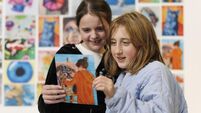What is myopia and can it be caused by children spending too much time on screens?

10-year-old Hollie Lawlor, whose myopia was caught early. Picture: Gareth Chaney.

- “Spending more time outside in natural daylight has been scientifically shown to support healthy eye development. Many children simply aren’t getting enough outdoor time in their daily routine.”
- “Especially when your child is using handheld screens — encourage them to hold the device no closer than 30cm from their face. They should also take a break after no more than 30 minutes of continuous use. Additionally, aim for them to spend at least two hours outdoors daily. These practices help protect their eyes — and promote overall wellbeing.”
- “While screens are an undeniable part of modern life, reducing prolonged screen use is key, especially for developing eyes.”
- “We recommend children’s eyes be tested every year to ensure they remain healthy during this important developmental stage.”







